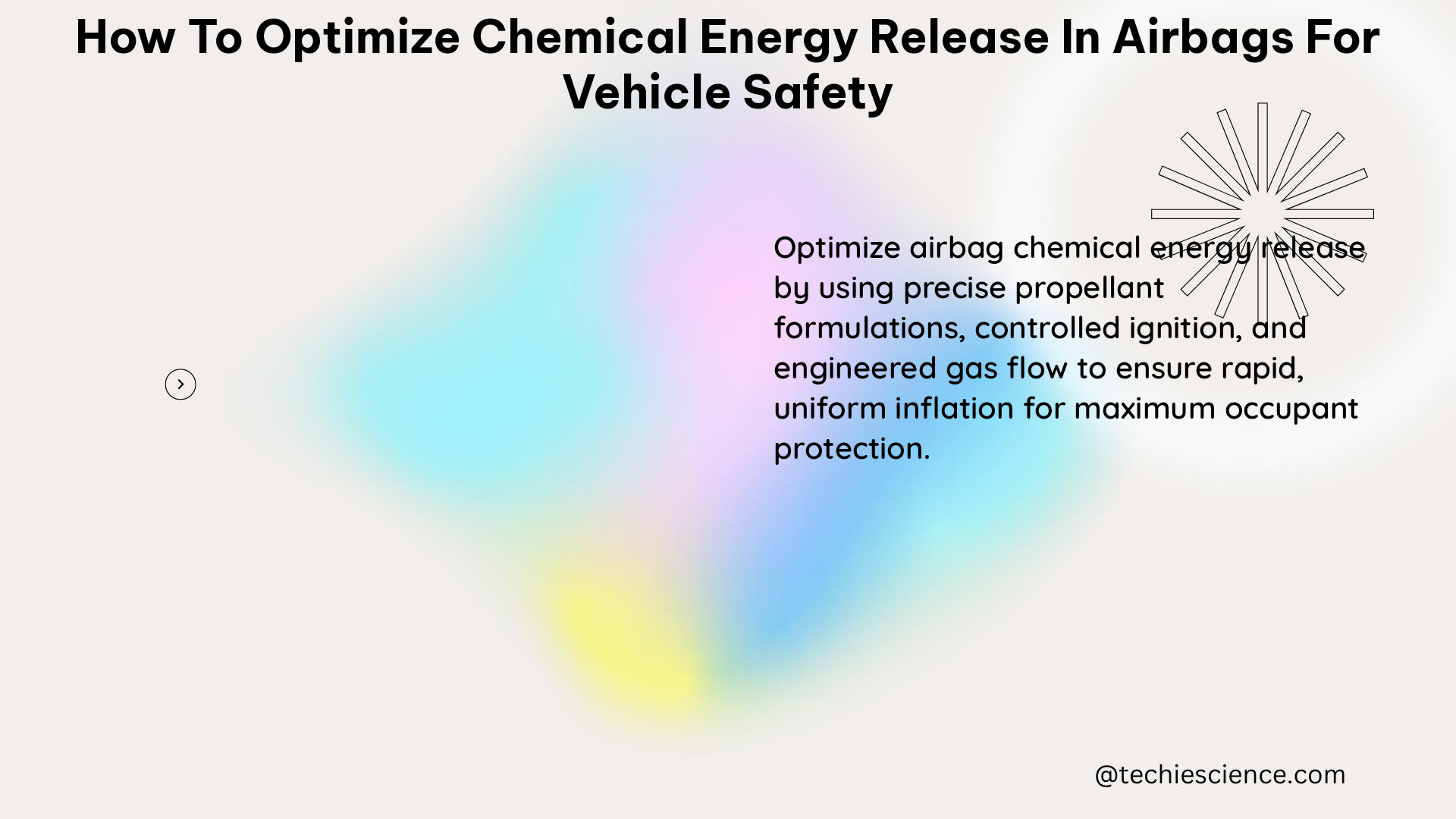Airbags are a critical safety feature in modern vehicles, designed to protect occupants in the event of a collision. The effectiveness of airbags is largely dependent on the efficient release of chemical energy, which inflates the airbag within a fraction of a second. This article delves into the intricate details of optimizing the chemical energy release in airbags to ensure maximum safety and performance.
Understanding the Chemistry of Airbag Inflation
The key chemical reaction that powers the inflation of airbags is the decomposition of guanidinium nitrate, a compound that rapidly decomposes into nitrogen gas, water, and carbon when ignited. This reaction must be carefully controlled to ensure that the airbag inflates within the critical 10-30 millisecond window following a crash.
The Guanidinium Nitrate Reaction
The chemical equation for the decomposition of guanidinium nitrate can be represented as follows:
CH6N4O3 (guanidinium nitrate) → N2 (nitrogen gas) + H2O (water) + C (carbon)
This exothermic reaction releases a significant amount of energy, which is used to rapidly inflate the airbag. The rate and efficiency of this reaction are crucial in determining the performance of the airbag system.
Factors Affecting the Reaction
To optimize the chemical energy release, it is essential to consider the following factors:
- Temperature: The temperature of the reaction can significantly impact its rate and efficiency. Higher temperatures generally result in faster decomposition and more efficient inflation.
- Pressure: The pressure within the airbag canister also plays a role in the reaction. Increased pressure can enhance the rate of decomposition and the speed of inflation.
- Catalysts and Inhibitors: The presence of certain additives, such as copper nitrate, can act as catalysts, reducing the temperature of the exhaust gas and making the reaction more efficient. Conversely, inhibitors can slow down the reaction, which may be desirable in certain situations.
Airbag Design and Optimization

In addition to the chemical factors, the physical design of the airbag itself can also impact its performance and energy release characteristics.
Airbag Size and Shape
The size and shape of the airbag can influence its ability to absorb energy and protect vehicle occupants. Larger airbags may provide more coverage, but they also require more chemical energy to inflate. The shape of the airbag can be optimized to ensure efficient energy distribution and effective cushioning.
Airbag Material
The material used to construct the airbag can also affect its performance. Factors such as tensile strength, tear resistance, and flexibility can all influence the airbag’s ability to absorb and dissipate energy during a collision.
Airbag Deployment Timing
The timing of airbag deployment is critical to ensure optimal protection for vehicle occupants. Airbags must inflate within the 10-30 millisecond window following a crash to be effective. Precise control over the chemical reaction and the physical design of the airbag system are essential to achieve this rapid inflation.
Airbag Maintenance and Safety Practices
To maintain the optimal performance of airbag systems, regular maintenance and adherence to safety practices are crucial.
Airbag Inspection and Replacement
Airbags should be inspected regularly, and any signs of wear or damage should be addressed immediately. If the airbag light on the dashboard is illuminated or blinking, it is a clear indication that the airbag system requires attention and should be serviced by a qualified technician.
Airbag Safety Practices
Proper seating position, seatbelt usage, and keeping children out of the front seat are essential practices to ensure the maximum effectiveness of airbags. Airbags are designed to work in conjunction with seatbelts, and their performance can be compromised if these safety guidelines are not followed.
Quantifiable Data and Performance Metrics
Studies have shown that the use of airbags can significantly improve vehicle safety. According to the National Highway Traffic Safety Administration (NHTSA), frontal airbags have been found to reduce fatalities by 29% for drivers and 32% for front-seat passengers aged 13 and older in frontal crashes. Additionally, side airbags with head protection have been shown to reduce driver death in driver-side crashes by 37% in cars and 52% in SUVs.
These statistics highlight the importance of optimizing the chemical energy release in airbags to ensure maximum protection for vehicle occupants.
Conclusion
Optimizing the chemical energy release in airbags is a critical aspect of vehicle safety engineering. By understanding the underlying chemistry, physical design factors, and maintenance practices, engineers can develop and maintain airbag systems that provide reliable and effective protection in the event of a collision. This comprehensive guide has provided a detailed overview of the key considerations and best practices for optimizing chemical energy release in airbags, empowering physics students and professionals to contribute to the ongoing advancement of vehicle safety technology.
References:
- Air Bag Safety Tips: How to Maximize Effectiveness – State Farm®. (n.d.). Retrieved from https://www.statefarm.com/simple-insights/auto-and-vehicles/how-to-maximize-air-bag-effectiveness
- What chemicals make airbags inflate, and how have they changed? (2022, November 15). Retrieved from https://cen.acs.org/safety/chemicals-make-airbags-inflate-changed/100/i41
- That’s One Fast Reaction! – American Chemical Society. (n.d.). Retrieved from https://www.acs.org/education/outreach/celebrating-chemistry-editions/2021-ncw/air-bags.html
- How to Get the Most Out of Your Airbag – Safety – Automotive Fleet. (2023, October 18). Retrieved from https://www.automotive-fleet.com/10208493/how-to-get-the-most-out-of-your-airbag
- Airbag – Optimize IAS. (2022, January 16). Retrieved from https://optimizeias.com/airbag/

The lambdageeks.com Core SME Team is a group of experienced subject matter experts from diverse scientific and technical fields including Physics, Chemistry, Technology,Electronics & Electrical Engineering, Automotive, Mechanical Engineering. Our team collaborates to create high-quality, well-researched articles on a wide range of science and technology topics for the lambdageeks.com website.
All Our Senior SME are having more than 7 Years of experience in the respective fields . They are either Working Industry Professionals or assocaited With different Universities. Refer Our Authors Page to get to know About our Core SMEs.